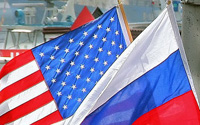US media paint Russia black as Obama prepares to visit Moscow
US media have already started covering Barack Obama’s forthcoming visit to Moscow on July 6-8. USA’s leading newspapers try to provide extensive reports about the economic and political life in Russia, as well as about the events in the Russian society and culture. Therefore, they create their own image of Russia, which, of course, may not be true. Unfortunately, the articles from US journalists are presumably negative.

The Washington Post published an article titled “Russia, Again Evading History” on June 20. The author, Masha Lipman, writes about Russia’s initiative to set up a committee to struggle against the falsification of history. Lipman believes that the Russian government intends to perfect the past of the nation and its leaders using the memories of the Second World War as a cover. For some reason, the author is certain that the committee will not let professional historians discuss and study thorny subjects.
Does Masha Lipman know that Vladimir Putin visited the Butovo Range Ground in Moscow in the autumn of 2007, where thousands of priests and other political prisoners were executed 70 years ago? As for the committee, it includes many professional historians as its members: Andrey Sakharov, the Director of the Institute for Russian History, Natalia Narochnitskaya, a former deputy of the Russian parliament, Nikolai Svanidze, a TV host, as many others.
On June 21, Time published an article titled “Russia Cracks Down on Political Art.” The article is devoted to the arrest of an artist from the city of Voronezh , who attempted to hang a collage on the building of the regional administration. The collage depicted Vladimir Putin superimposed over the head of a woman wearing an evening gown. The slogan on the picture read: “Oi, I really don’t know…a third presidential [term]?...Well, that’s too much, although all good things come in threes.”
We wonder how the NYPD would react if an American artist tried to make a similar collage with the image of George W. Bush or Barack Obama. The penal codes of many countries contain criminal articles about insulting state officials, not to mention the fact that governmental premises are not meant for art shows.
The Washington Post followed with its own headline – “Far Eastern City Sees Kremlin as Cause of Its Troubles.” It goes about the actions of protest in the city of Vladivostok, when many of its residents protested against increased tariffs to import foreign-made cars (presumably from Japan). The author slams the Russian government for its inability to handle the influence of the economic crisis in the country, but provides no comparison of how the governments of other countries struggle againstthe crisis. The article says nothing about the fact that the meetings in Vladivostok could not be described as ‘mass riots.’
Bloomberg News Agency said: “Russia’s Anti-Crisis Plan Won’t Boost Growth.” The author of the article says that Vladimir Putin is unable to take his nation to the level when the country starts to develop steadily. The article criticizes the measures of the Russian government to support the domestic car industry, agriculture and the government’s intent to reduce the support of the banking sector by 500 billion rubles.
The New York Times published an article titled: “Ikea Plans to Halt Investment in Russia.” The story is about the decision of the Swedish giant to suspend its investment projects in Russia over corruption. This subject seems to be a threadbare theme for American readers. Is the corruption level in Georgia or Ukraine , for example, lower than that in Russia? That does not seem to be likely, but US authors are not willing to provide any analysis about it.
A different subject appeared on The Wall Street Journal. In the article titled “Mahmoud’s Friend” Russia is criticized for recognizing Mahmoud Ahmadinejad’s victory at the recent presidential election in Iran instead of supporting the local opposition. The journal described the victory of the sitting president as “fraudulent.”
“The Kremlin backs this regime for Machiavellian purposes. Mahmoud makes life difficult for America, for one thing. Iran is also a big customer of Russian goods, especially weapons. Perhaps most of all, the prospect of another successful so-called "color" democratic revolution in the neighborhood - in this case, green - sends chills down Russian strongman Vladimir Putin's spine,” the article said.
Again, for some reason, the WSJ said nothing about Moscow’s concerns in connection with the growth of violence in Teheran.
To summarize, US readers are told that Russia is a dictatorship, that the Russian government runs improper economic policies, that Russian artists are not allowed to express their talents, that Russia conceals the truth about its history and supports anti-democratic regimes in other countries.
US journalists do not want to give Russia any credit for anything. There is not even a word that, for example, first man in space was a Russian, that Chaikovsky is one of the most recognizable composers in the world, that historical and cultural monuments are plentiful in Russia, that Russian newspapers criticize the Russian government on a regular basis.
One is left to hope that President Obama is not a politician who easily follows newspaper stereotypes.
Vadim Trukhachev
Pravda.Ru
Subscribe to Pravda.Ru Telegram channel, Facebook, RSS!




